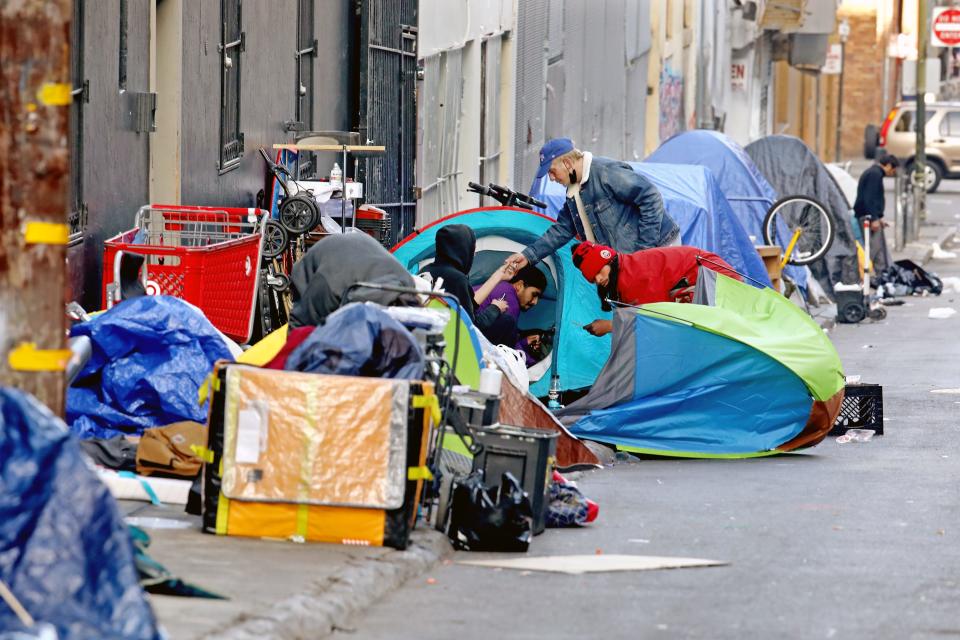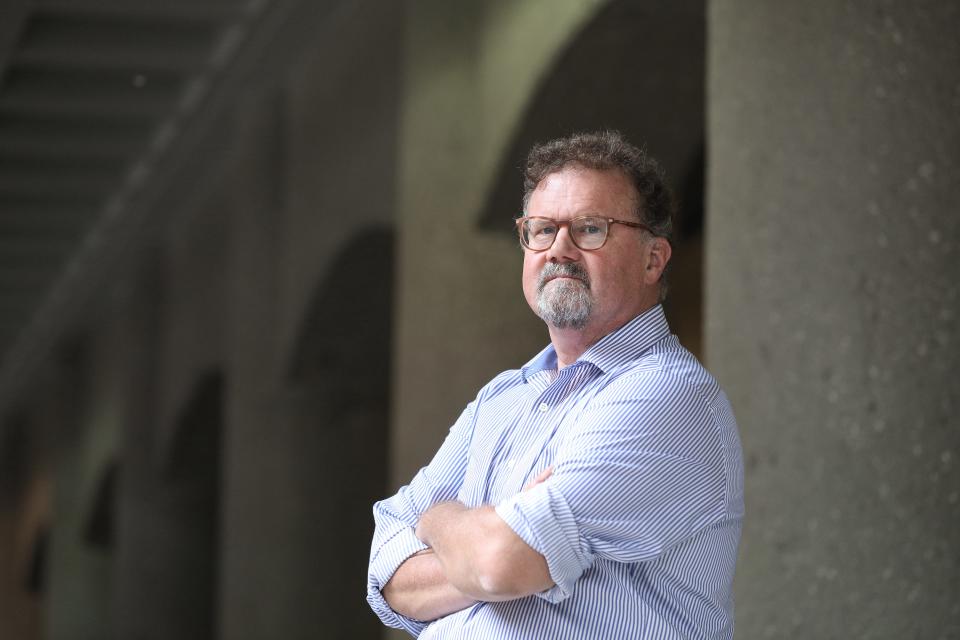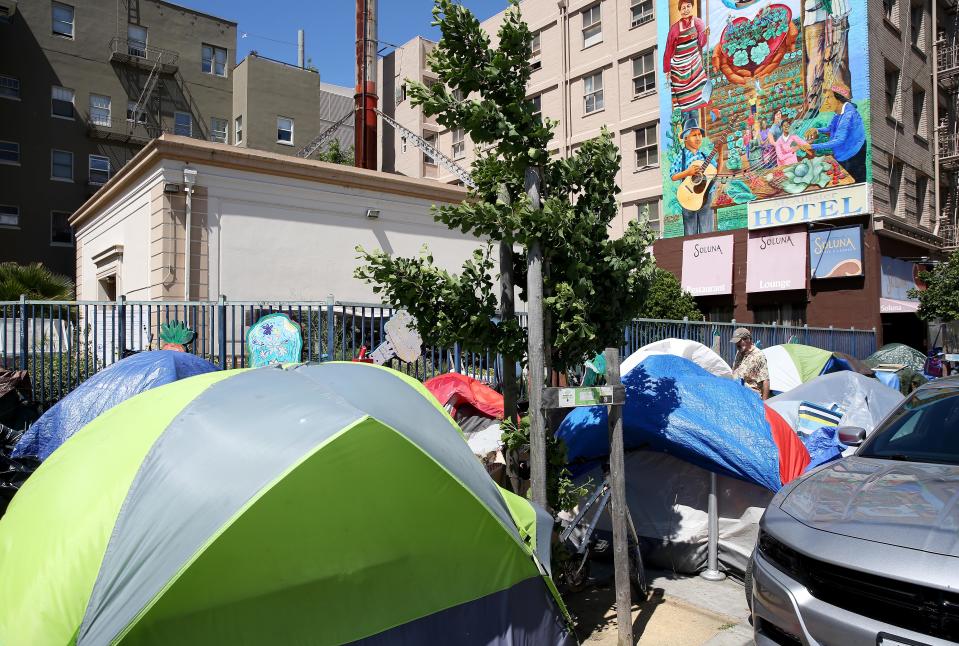'I was killing myself': San Francisco program giving alcohol to addicts may save lives
SAN FRANCISCO – The toll of homelessness and decades of substance abuse is evident in Bruce and Lisa, two clients of San Francisco’s controversial Managed Alcohol Program, from her missing teeth and gravelly voice to his bloodshot eyes.
He once dropped a bottle of gin and then sucked the spilled liquid off the floor with a straw, desperate for the alcohol. She recently ventured out of the residential program’s building in search of additional booze and promptly wound up in a hospital with a broken arm she still can’t explain.
One fact they’re both clear on: Without the innovative city venture, they would be dead by now.
Under MAP, as the initiative is known, up to 20 homeless people with severe alcohol use disorder are housed in a former hotel and given predetermined doses of liquor at specific intervals.
It’s not exactly happy hour at the corner bar. The drinks, dispensed by nurses as a form of medication, are meant to prevent the clients from becoming overly intoxicated while avoiding the worst effects of withdrawal, which may lead to seizures and can be fatal for those physically dependent on alcohol.
The need goes well beyond San Francisco. The Centers for Disease Control and Prevention says about 178,000 Americans die every year of excessive alcohol use.
MAP focuses on a small subset of the homeless population with the most severe alcoholism – a group that drains a disproportionate share of the city’s emergency resources – and it has drawn fire from critics who contend San Francisco is spending millions of dollars enabling addiction.
Bruce and Lisa offer a counterpoint.
“Before I came to MAP, I was drinking my breakfast, lunch and dinner. I couldn’t even walk. I was a total mess,’’ said Bruce, 65, who along with Lisa spoke on condition their last names not be used because of safety concerns. “MAP has helped me take my medications, make my appointments. I wouldn’t be doing all that if it wasn’t for this program. They saved my life.’’
Said Lisa, 62: “I was killing myself. I would have been dead for sure if they had not taken me in.’’

'Science is very strong' in showing benefits
The notion of a famously liberal city providing free drinks to alcoholics has made for easy fodder in some conservative circles, with “taxpayer-funded’’ vodka played up in headlines. Officials with San Francisco’s Department of Public Health say clients and staffers have been harassed in person and online by right-wing media outlets whose personnel have approached them during outings and taken photos through the closed building’s windows.
Dr. Paul Linde, a substance abuse expert and longtime city resident, concedes that "on the face of it, to the average person this does seem nuts.''
But Linde, a professor emeritus at the University of California, San Francisco, who provided psychiatric emergency services at S.F. General Hospital for 24 years, said there’s solid science behind the idea of limiting the damage caused by addiction.
MAP relies on harm reduction, a model that emphasizes decreasing the negative effects of substance use without requiring abstinence. Linde said harm reduction is better understood in relation to intravenous drug use that can lead to communicable diseases such as AIDS, hepatitis C and other infections. He believes the concept also is applicable to alcohol abuse, which can result in liver, heart and brain damage in addition to an increased risk of cancer.
“The science is very strong in showing physical health, mental health and quality of life benefits from reducing and not needing to stop,’’ said Linde, adding that patients on harm reduction typically drop their substance use by 50% to 75%. “From a public health perspective this program makes a ton of sense. It’s not just the alcohol, it’s the contact and the social support that’s there, and the door is always open for more traditional treatment if people want it.’’
Traditional treatment, espoused by Alcoholics Anonymous and the Salvation Army, among others, is based on abstinence. Linde said that focus sometimes leads to a rigid mentality among those whose lives have benefited from absolute sobriety and see it as the only way to overcome alcohol use disorder (AUD).

Recovery possible without abstinence, NIAAA says
Two years ago, the National Institute on Alcohol Abuse and Alcoholism changed its definition of recovery, and it no longer requires abstinence. “An individual may be considered ‘recovered’ if both remission from AUD and cessation from heavy drinking are achieved and maintained over time,’’ the institute says on its website, defining such “cessation’’ as having no more than 14 drinks a week for men and seven for women, with limits on the daily amounts.
Linde, now a medical director for the telehealth care provider Ria Health, said some of his patients thrived by going through the AA program and others floundered.
“AA is terrific for some people. AA has saved countless lives,’’ Linde said. “It’s a wonderful model, but only if it’s a good fit for the individual. It’s not the only way to recover from alcohol use disorder. It’s one way.’’
There are plenty of skeptics about San Francisco’s embrace of harm reduction, including its mayor, London Breed. In February, Breed said the approach was ineffective and was “making things far worse’’ when it comes to the city’s soaring fentanyl-related deaths.
But Breed has not cut MAP’s $5 million yearly budget, and her spokesman Jeff Cretan said via e-mail that the program helps the city keep some of its most problematic people “off the streets and indoors, while trying to get them connected to more services.’’
Better uses for the money?
Krystyl Wright, a licensed clinical social worker and psychotherapist with Diamond Recovery Group based in Los Angeles, said she would prefer to see the money assigned to MAP spent on treatment for more people, especially the most vulnerable, including those without health insurance or stable housing.
“I am not in total disagreement with harm reduction,” Wright said. “But I am concerned because alcoholism is an addiction. … I see (MAP) as enabling, and if we’re thinking of bringing this to Los Angeles, I pray we keep it as a pilot program. … I don’t think this is a one-off solution.”
Lisa and Bruce said they've tried to quit drinking before without success. They both acknowledge past drug use – crack and crystal meth for her, meth and IV drugs for him. Bruce, who has been at MAP for five months after years of bouncing from one emergency room to another, said he hasn’t injected drugs in more than 10 years.
“That was easier to quit than alcohol. The alcohol, that’s the beast of all beasts,’’ said Bruce, who has battled drinking problems for 45 years and ultimately wants to achieve sobriety. “MAP has helped me somewhat get rid of that beast. Some of the medication I’m taking, I don’t have the cravings I used to have.’’
Health officials say that though versions of MAP were used elsewhere as part of isolation and quarantine efforts during the COVID-19 pandemic, San Francisco is the first city to implement the model permanently. Fifty-five clients have gone through the treatment − they're expected to stay at least a year − and they're offered medication and therapy in addition to the drinks, which can be beer, wine or vodka.
Lisa joined MAP in its infancy during the early days of the pandemic in 2020, when officials trying to keep the city’s large homeless population safe placed them in hotels and motels. Some who were addicted to alcohol were provided liquor to allay their cravings and head off withdrawal. The surprising success of that endeavor begat the current undertaking.
At the time, Lisa said she was consuming more than a fifth of gin a day. She’s now down to four standard daily drinks.
“I would drink myself into a seizure and then fall and have somebody call an ambulance,’’ she said. “And then when I’d wake up in the morning, if I didn’t have a drink I’d have a seizure then. Since I’ve been at MAP all my seizures have stopped.’’
Major reduction in use of emergency services
Dara Papo, director of the health department’s Whole Person Integrated Care, oversees MAP, which began as a pilot program modeled after similar efforts in Canada and Europe.
Papo is aware MAP’s $5 million price tag and unorthodox approach make it a magnet for criticism. She points to the 2022 internal analysis that found the city saved $1.7 million over six months through a drastic reduction in emergency room visits (73%), emergency medical system activations (65%) and hospitalizations (45%) from frequent users of services enrolling in MAP.
Just as much as that, Papo highlights the human connections made by people who have regained “dignity they did not have when they were frequently found lying on the sidewalk in their own bodily waste.’’
A recent example featured a man who had transitioned to an abstinence-based program and, when stopping by to provide an update on his progress, shared the news that he had restored relations with his adult children and met a grandchild he didn’t know he had. In May, Bruce and other clients joined staffers in a birthday celebration for Lisa.
Papo lists caring for clients in a humane way, reducing use of emergency services and benefitting the community – through increased EMS availability and less interaction with distressed addicts – as three keys for MAP’s success.
“The endgame is stabilization and greater health and wellness,’’ Papo said. “We have some people that have chosen recovery. We have people that have gone from 18 drinks a day to two. They’re not sober, but they’re able to function having two drinks a day.’’

Can't walk in off the street and get a drink
Papo also corrected some misconceptions about the program, saying only staffers and clients are allowed in the facility – no one can just wander in for a free pop. She noted clients are referred to MAP and screened upon intake, then given an individualized care plan.
And while the department offers other rehabilitation services with the goal of abstinence, Papo said MAP has been most effective at stabilizing those with chronic, severe alcoholism, who commonly reduce their consumption even if they don’t quit drinking altogether. Also, department officials say, none of the booze used in the program is purchased with taxpayer dollars.
The San Francisco Fire Department has endorsed MAP, saying in a statement that its members know well how frequently chronic alcoholics require emergency services – some of them daily – and calling the initiative “an incredibly impactful intervention’’ in reducing unnecessary calls.
“Since MAP’s inception in 2020, our Department has seen a marked decrease in EMS utilization from this small but highly vulnerable population,’’ the statement said.
Vitka Eisen, CEO of HealthRIGHT 360 – a San Francisco nonprofit that advocates for treatment of substance use disorder – said some alcoholics will ingest hand sanitizer or mouthwash to avoid withdrawal if they can’t access liquor.
Gary McCoy, the organization’s vice president, can relate. McCoy, 45, said his use of heroin, meth and alcohol caused him to shuttle between homelessness and jail until finding sobriety – and sticking with it − through a harm reduction program more than 14 years ago. He sees the approach as a valuable tool to get addicts into recovery and eventually abstinence but realizes the backlash it can evoke.
“That's the problem with stigma,’’ McCoy said. “When you start bringing your morals into things, you forget to look at the bigger picture, and the data and the research that support programs like this.’’
This article originally appeared on USA TODAY: San Francisco managed alcohol program offers addicts limited drinks


